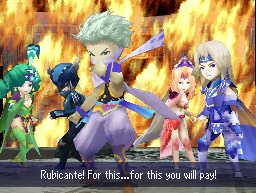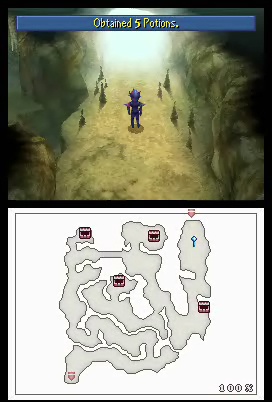More than 15 years ago, SquareSoft shocked the world with its masterpiece Final Fantasy II (which was actually the fourth game in the series but only the second released in North America). For the first time, console role-players weren't given a few generic heroes and charged with stopping the evil wizard and saving the world; instead, they were introduced to a wide assortment of realistic characters who struggled with complex adult issues such as love, hate, honor, duty, betrayal, and redemption. Now, this epic saga has been entirely remade in 3D on the Nintendo DS, and whether Cecil, Kain, and Rosa are new faces or old friends, this is one adventure that you shouldn't miss.
Cecil is a man with a dilemma. Though bound by his duty as the lord captain of the Red Wings of Baron to serve his king and country, his conscience is heavy with the sins that he is committing in their name. The formerly loving and caring king who took Cecil in as a child and taught him the ways of the dark sword has become a sinister and greedy tyrant who covets the sacred crystals of the world for reasons unknown. Upon returning from a mission to Baron's friendly neighbor Mysidia, in which Cecil and his men were forced to steal one of the crystals like common thugs, he finally dares to question his king's motives. For his insubordination, Cecil is stripped of his rank and sent on an errand north to the village of Mist, where his destiny is revealed to him and his journey of atonement begins.
Throughout his quest, Cecil is joined by a number of intriguing characters: Kain, his best friend and a dragoon of considerable skill; Rosa, his lady love, who became a white mage to support him on the frontlines; Rydia, a summoner capable of calling the legendary Eidolons (referred to as summon monsters in other games) to her aid; Tellah, a revenge-driven sage who's forgotten more than most have learned; and many more. Together, they represent some of the most diverse and thoroughly fleshed-out characters in the long history of the Final Fantasy series. Standing on the other end of the spectrum across a sea of monsters is the sinister Golbez, a larger-than-life mastermind of evil clad in full body armor as black as night. His lieutenants, the four elemental archfiends, are equally memorable, particularly the urbane Rubicante, who insists on healing your wounds before doing battle with you so that you can fight him with all your might.

Golbez and his goons may have most of the cards, but that doesn't mean that Cecil and his pals don't have an ace or two up their sleeves. Each of the characters that make up your party have a set class that they grow more powerful in as they gain levels. Each class has its own unique abilities, such as the dark knight's darkness, which casts a self-buff that doubles damage for a few turns at the price of the wielder's own HP, or the sage's recall, which randomly casts an otherwise unavailable high-level spell. Though class-specific abilities aren't anything new, in this DS remake you now have the power to customize your characters by giving them additional abilities called augments. Augments can be found throughout the world, given to you by leaving party members, or even stolen from certain enemies, and they can do everything from passively increasing stats such as HP and MP to granting class-specific abilities like darkness or recall to normally nonqualifying characters. If you look hard enough, you may even be able to learn the abilities of the elemental archfiends, such as Cagnazzo's tsunami attack.
If you're willing to put the time into experimenting with augments, you will uncover a slew of powerful combinations that just may give you the edge you need--and you'll need all the help you can get because the difficulty in this iteration of Final Fantasy IV has been increased tremendously. A majority of the bosses require very specific strategies to defeat, and the uninformed will likely perish several times in these encounters before they grasp how to claim victory. Even if you're a seasoned veteran who knows all of the tricks, don't expect things to be simple; some bosses have changed just enough to throw you off of your game, and all of them are a lot tougher than you remember. By the end of the game, even the normal monsters found in random battles are tough enough to wipe the floor with a superpowered party of heroes if they're unprepared.
Besides the radical addition of the ability to customize your party, several other minor gameplay tweaks have been made. The characters in your party now share their thoughts with you on the menu screen, offering personal anecdotes and potentially helpful advice about the current situation. An entirely new quest line featuring Namingway--a moogle-like wanderer who in the original version was satisfied with renaming your characters when asked to--has been added, in which Namingway renames himself as he tries out a number of different professions with humorous results. Finally, Rydia receives a unique new Eidolon named Whyt that can be completely customized by conversing with Fat Chocobo, who fans will likely remember as a bank for extra-item storage (that service is no longer necessary because the item cap has been removed). Through Fat Chocobo, you can customize Whyt's appearance, assign him an assortment of attacks, level up his various stats by participating in touch-screen-heavy minigames, and even battle your friend's incarnations of Whyt in one-on-one matches via local DS wireless.

However, outside of Whyt's minigames, there isn't much going on with the touch screen. When not in battle, the bottom screen is occupied by an area map that automatically fills as you explore dungeons, and it's possible to navigate your party around the world by manipulating the stylus. At most other times, the touch screen is nonfunctional. Thankfully, the button controls are very effective, and so it's generally best to not even try to mess around with your stylus.
Final Fantasy IV is easily among the best-looking 3D games on the Nintendo DS. The heavily stylized characters are impressively expressive, from the manner in which Cecil broods as he reflects on his guilt to the way that Rydia hops up and down and waves her hands to get your attention at a shop when you find something that she can equip. Now that dungeons are rendered in three dimensions, there is a vast sense of size and depth (particularly in the final dungeon) that wasn't previously there, and it makes your journey seem that much more awe-inspiring and epic. As part of the new graphical update, key moments of the game are shown off in cinematic-style cutscenes, many of which are accompanied by full voice acting for the characters. Unfortunately, as excited as series fans may be to finally hear Cecil speak, the voice acting is actually the game's weakest point. Some voices seem completely out of character or introduce unnecessary melodrama.
Although it has been rereleased several times throughout the years, this full remake of one of the most celebrated stories in video game history is in many ways more poignant and impressive than it was all those years ago, despite minor irks with the voice acting. With a cast of memorable characters and villains, a more accurate and authentic translation, a new skill-customization system, and a few important new story elements that help to better explain key plot points, this is the definitive version of Final Fantasy IV that everyone should experience.